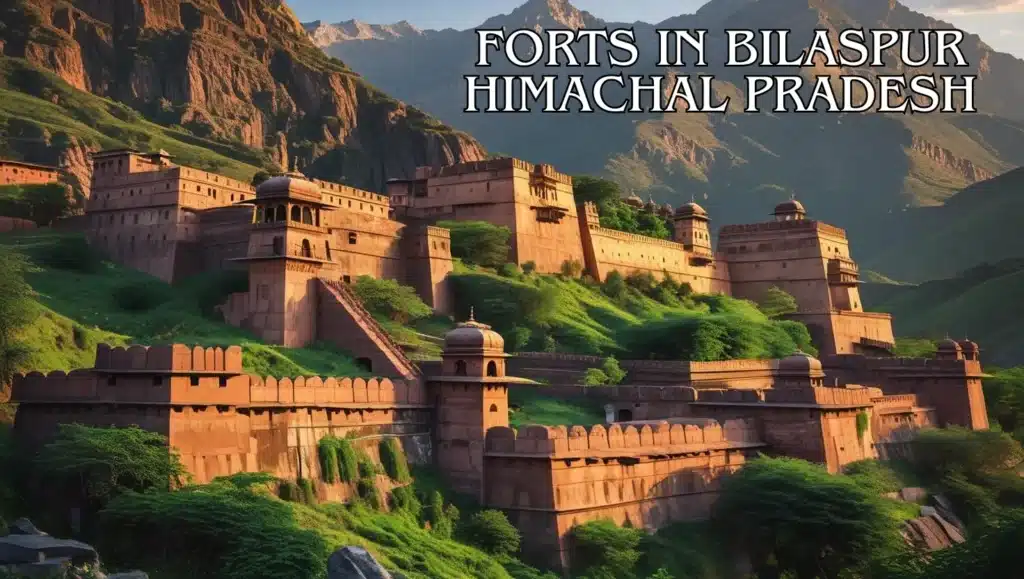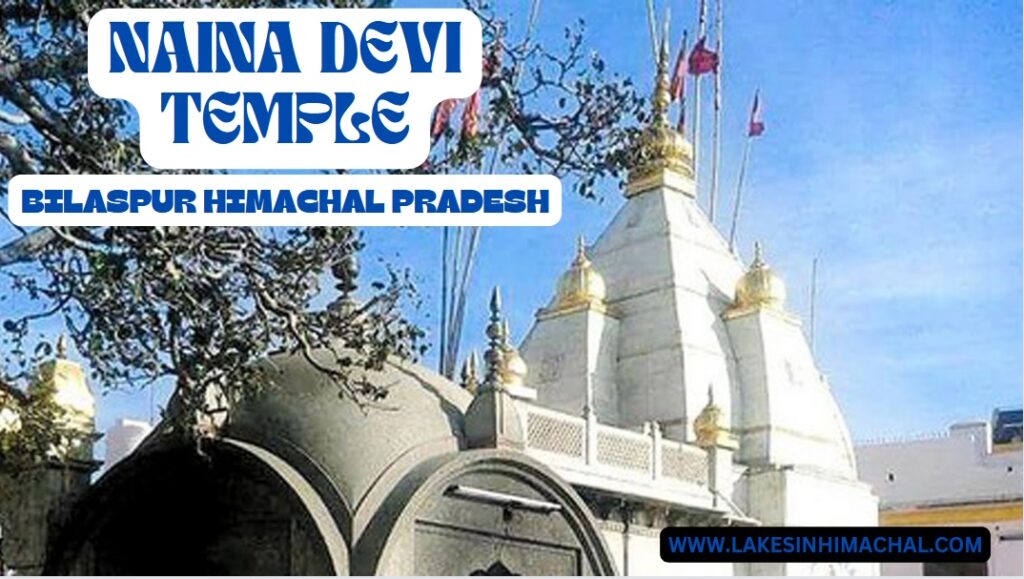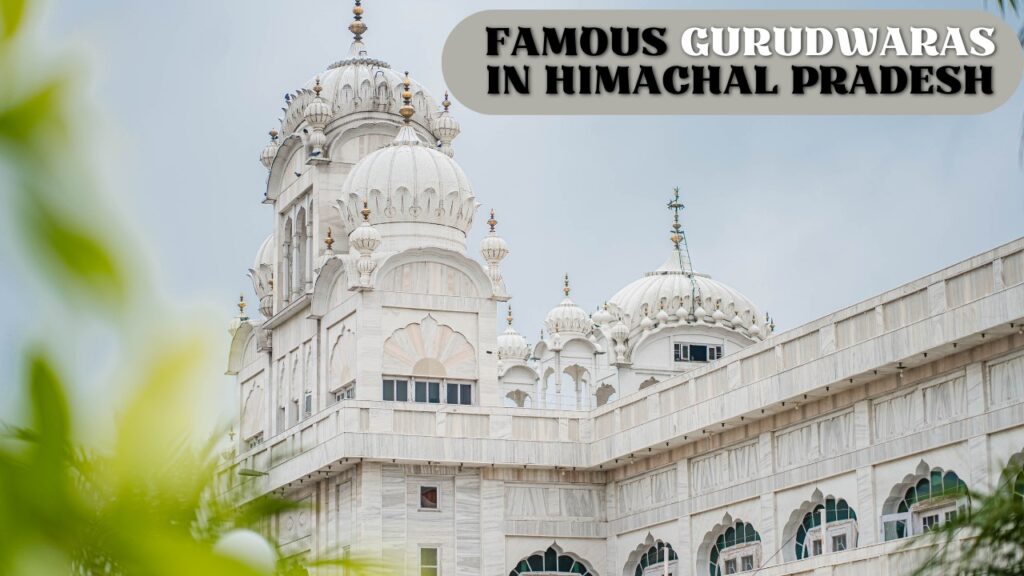Bilaspur is also one of the beautiful hill stations in Himachal Pradesh. National Highway 3, which runs between Chandigarh and Manali, passes through Bilaspur. Bilaspur was known as Kahlur in ancient times. Various kings ruled here and constructed their forts and temples. These forts lie in ruins today, but are part and parcel of a glorious history. Some of the famous forts in Bilaspur are as follows:-
Table of Contents
ToggleBahadrupur Fort
Bahadrupur Fort was built during the reign of the Katoch dynasty by Raja Keshab Chand in the 16th century and served as a stronghold of the rulers of the area. Sadly, nothing remains of the fort, not even ruins, but the area still retains its historic charm. Situated at a height of 6200 feet, Bahadrupur Dhar (Hill), where once this magnificent fort stood, is today a popular tourist spot that can leave you enthralled with its beauty and aura. The lush green surroundings with dense forests give this place a charm of its own.
What are the Attractions
As the Bahadurpur Fort is located in the vicinity of the Bilaspur town, locals and tourists alike visit this place to get a break from their busy lives. It is an ideal picnic spot. During winter, the place also gets snowfall now and then. The site offers panoramic views, dense forests of Deodar and Ban trees, and occasional snowfall in winter. There is a guest house and tourist facilities here. The place also offers trekking options to tourists so they can have an adventurous trip as well.
How to Reach Bahadurpur Fort
The fort is situated on Bahadurpur Hill, near Tepra village, at an elevation of 6200 feet. It is located 40 km from Bilaspur and easily accessible via NH205 and NH154. Visitors must climb up the hill to reach the fort ruins.
Kahlur Fort
In ancient times, Bilaspur was known as Kahlur, a princely state even during British India. The Kahlur Fort was built by the ruler of Kahlur, Raja Bir Chand, who ruled between 697 and 730 CE. Today, the fort lies in ruins and only the stone structure is visible. You will see narrow corridors, stone staircases, stone walls, pathways, and the entrance of this ruined fort.
What are the Attractions
Its close proximity to Bilaspur makes Kahlur Fort a popular destination for picnickers, history enthusiasts, and those who appreciate architecture. Visitors will be particularly amazed by the unrivalled panoramic vistas from the fort’s peak, offering a spectacular sight of verdant hills bathed in the clear blue sky.
Sariyun Fort
Next in the list of famous forts in Bilaspur comes Sarun Fort. This fort was built during the reign of the Katoch dynasty in the 17th century and served as a stronghold of the rulers of the area. The fort is now in ruins but still retains its historic charm and is a popular tourist spot. The fort stands approximately 12 m high. One interesting thing, as per local belief, is that its walls are made out of a peculiar kind of stone which cannot be used or reused to build any other house. The stone structure of this fort can still be seen in a few places. There are stone pillars, a hole for cannons, which is still visible in this fort. There is a small temple of Naina Devi in the fort.
How to Reach Sariyum Fort
Sariyun Fort is located at a distance of 30 km from the Bilaspur town. To reach the fort, first you have to drive up to the Kandrour bridge, which is located approx 10 km from Bilaspur town, cross the bridge, and from there the fort is at a distance of about 20 km.

Bachhetru Fort
Bachhretu Fort, which was once a powerful fort in Bilaspur, lies in the Kot hills of Bilaspur. It was built somewhere in the 14th century during the reign of Raja Ratan Chand. This was once a massive fort extending to several kilometres. You can still see some rooms and sections of this fort even now. The shape of the fort was rectangular and built with stones. The walls were estimated to be 20 meters in height. The thickness of its walls is estimated to have been one metre, tapering towards the top. There were numerous rooms inside the fort. Some of the walls of this fort are still intact after all these years. There is a small temple, housing two busts of the goddess Asht Bhuja (eight-armed) and some other deities.
What are the Attractions
The fort offers a magnificent view of Gobind Sagar Lake and the surrounding hills. It has ancient walls, a water tank, and a temple dedicated to Goddess Asht Bhuja.
How to Reach Bachhetru Fort
Bachhetru Fort is situated on Kot Hill, near Shahtalai, at an elevation of 3000 feet above sea level. The distance from Bilaspur town is about 34 km, accessible via Jhandutta road and Berthin-Deotsidh road. Rented taxis or private vehicles are the best options.
Ratanpur Fort
The Ratanpur Fort in Bilaspur, Himachal Pradesh, distinctly separate from its namesake in Chhattisgarh, stands as a testament to the region’s royal past, situated atop the scenic Ratanpur Dhar, approximately 35 kilometres from Bilaspur town. Believed to have been built by Raja Dayanand, this roughly 300-year-old fort offers breathtaking panoramic views that encompass the majestic Himalayas and the sprawling Gobind Sagar Lake. Though now largely in a dilapidated state due to the ravages of time and neglect, its ruins still hint at a strategic importance and former grandeur, serving as a silent witness to centuries of history in the erstwhile princely state of Bilaspur.
The Attractions
Beyond its historical walls, the Ratanpur Fort in Himachal Pradesh also holds cultural significance. It is home to an ancient Shiva Lingam, indicating its role as a place of worship even after its military prominence waned. While not as extensively preserved or developed for tourism as some other historical sites, its location provides an excellent vantage point for nature enthusiasts and those seeking a glimpse into the architectural legacy of the region. The fort, sometimes referred to as “Khui Kila,” beckons adventurers and history buffs to explore its crumbling structures and imagine the lives of the rulers and soldiers who once walked its grounds, offering a unique blend of historical intrigue and natural beauty.

Other Tourist Attractions in Bilaspur, Himachal Pradesh
There are seven hills in Bilaspur called Naina Devi, Kot, Jhanjiar, Tiun, Bandla, Bahaurpur and Ratanpur, which are also attractions in themselves. Besides the above-mentioned forts in Bilaspur, there are many other tourist attractions in the district of Bilaspur, which are as follows:-
Naina Devi Temple
The Shri Naina Devi Ji Temple is one of the most revered Shakti Peeths in India, located in Bilaspur, Himachal Pradesh. It sits atop a hill at an altitude of 1,219 meters, offering breathtaking views of the surrounding landscape. The temple is believed to be the place where the eyes of Goddess Sati fell when Lord Vishnu cut her body into pieces. Built by Raja Bir Chand in the 8th century, it has been a major pilgrimage site for centuries.
The temple is associated with several mystical folk tales, making it a sacred place for devotees. The temple complex features idols of Goddess Naina Devi, Lord Ganesha, and Kali Devi. A ropeway is available for visitors who prefer an easier ascent to the temple. Major festivals like Navratri and Shravan Ashtami are celebrated with grand fairs, attracting thousands of devotees.
Gobind Sagar Lake
Gobind Sagar Lake is a man-made reservoir located in the Bilaspur district of Himachal Pradesh. It was created by the construction of the Bhakra Dam on the Sutlej River. The lake offers stunning views of the surrounding mountains and is a popular spot for water sports and fishing. The lake is also a bird-watching paradise, with over 50 species of migratory birds visiting it during the winter months. In summer, you can also view the submerged temples here.
Ranganath Temple
The Rangnath Temple in Bilaspur is a cluster of ancient temples that once formed the heart of Old Bilaspur town. These temples, primarily built in the Nagara style and dating back to between the 6th and 16th centuries (with significant artwork from the 8th-9th century), were submerged in the 1960s and 1970s following the construction of the Bhakra Nangal Dam and the subsequent creation of the Gobind Sagar reservoir.
What makes them remarkable is their occasional re-emergence, particularly during the winter and spring months when the water levels of the reservoir recede. This phenomenon makes them a poignant symbol of lost heritage and a unique pilgrimage site.
The largest of the temples is dedicated to Lord Shiva, while others are devoted to deities like Sitla-Durga, Vishnu, and Ganesha. The artwork found on these submerged structures, though subject to erosion from the water and silt, reveals intricate Hindu carvings that show similarities to Pratihara temples in other parts of India, while also possessing a unique style developed in the historic Himalayan Hindu kingdom of Kehloor. When the water levels drop and these ancient edifices become visible, they draw locals and tourists alike, who are captivated by the sight of these “lost treasures” seemingly rising from the depths.
Recognising the immense historical and cultural significance of these submerged temples, there are ongoing efforts to preserve and potentially relocate them. The Indian government has launched a significant project to move the Rangnath temples, along with other submerged heritage sites, to a higher level. This ambitious undertaking aims to not only protect these ancient structures from further erosion but also to establish Bilaspur as a year-round pilgrimage and tourism destination.
Kandrour Bridge
Kandrour bridge is located 8 kilometres from Bilaspur on National Highway No. 88 across the river Satluj. Its construction started in April 1959 and was completed in 1965. The span of the bridge is about 280 meters, with a breadth of about seven meters, and the height above the lowest river bed below is about 80 meters. This bridge provides a link between Bilaspur, Ghumarwin and Hamirpur districts, and is a marvellous engineering feat.
Bhakra Dam
Bhakra Dam is a concrete gravity dam located on the Sutlej River in the Bilaspur district of Himachal Pradesh. It is one of the highest dams in the world, standing at a height of 225 meters. There are two dams called Bhakra Dam and Nangal Dam, which are located close to each other, and together they are called Bhakra Nangal Dam. The dams provide water to the states of Rajasthan, Haryana, Punjab, and Himachal Pradesh. The dam generates hydroelectric power and is a major source of irrigation for the surrounding agricultural lands. The dam is also a popular tourist spot and offers stunning views of the surrounding mountains.
Baba Balak Nath Temple
Baba Balak Nath Temple is a famous Hindu temple located in the Hamirpur district of Himachal Pradesh. The temple is dedicated to the Hindu saint Baba Balak Nath, who is believed to have lived in the area in the 8th century. The temple is visited by thousands of devotees every year, who come to seek the blessings of the saint.
Laxmi Narayan Mandir
Among the many temples in Bilaspur, Himachal Pradesh, one of the most famous is Laxmi Narayan Mandir. Lord Vishnu and Goddess Laxmi are the main deities of Laxmi Narayan Mandir. The architecture of this temple is its most eye-catching sight. The temple is made of white marble and wooden pillars. There are idols of other gods and goddesses like Lord Shiva, Goddess Durga, etc.
Rukmani Kund
Rukmini Kund is a pond that was named after a woman called Rukmini, who sacrificed herself for a noble cause. It is said that there was a severe drought and famine in the Bilaspur area. The King of Bilaspur got his daughter-in-law walled up on the orders of his Kul Devi. It is believed that because of this sacrifice, there is no water shortage in the Bilapur area to this day. The water from Rukmini Kund can heal physical ailments. There is also a small temple and bathing area for the devotees. The entire area around Rukmini Kund is surrounded by lush greenery and natural beauty.
Vyas Cave
Vyas Cave is an old cave on the Sutlej river and is a popular tourist spot in Bilaspur Himachal Pradesh. According to locals, Sage Vyas, who wrote the epic Mahabharata, meditated in this cave for some days. Vyas Cave or Vyas Gufa is one of the most ancient places in Bilaspur. The cave is enclosed by pine and Juniper forests. There is a small temple near the entrance of the cave. The nearby attractions include Kalapani spring, Kali Mandir, Gunji, and Budhi.



